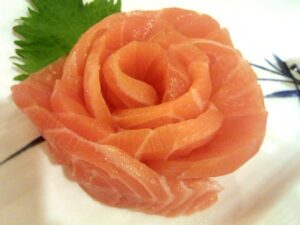Sake Sushi (Salmon Profile)
What is Sake (Salmon)?

The B.C. roll is perhaps the tastiest of all sake sushi. It is a Canadian invention which uses barbecued or grilled salmon and salmon skin along with sweet sauce, cucumber, and often mayo. The Alaska roll is very similar to the California roll, however salmon is used instead of imitation crab. Often, the roll is also wrapped in salmon. The Philadelphia roll is perhaps the best for illustrating my point that salmon sushi is a decidedly westernized creation: it includes raw or smoked salmon as well as cream cheese and cucumber, often accompanied by avocado and onion. It is a safe bet you would not find cream cheese being used in ancient Japan!
If you are new to trying salmon, and are the adventurous sort, sashimi is the best way to appreciate the fish. Sake sashimi is often paired with lemon and a small dab of wasabi, as well as perhaps a splash of soy sauce (shoyu). That is all that is needed to enjoy the fish in its most natural presentation.
Why is salmon different that other fish? It was never eaten raw in Japan until recently because of fears of parasitic worms. Now, salmon used for sushi is be flash frozen, usually as soon as the it is taken from the water. This process kills dangerous parasites and tapeworms while minimally affecting the quality, taste and texture of the fish.
It is not just the taste that has made sake such a popular ingredient in the western world. Salmon is very high in omega 3 fatty acids and protein, making it a tasty and sensible choice for sushi connoisseurs. We suggest looking for restaurants that serve wild salmon rather than formed, however, as the former is often a better choice as it has significantly more omega 3s than farmed salmon that grow up eating fish feed rather than their natural oceanic prey.
I have always been fascinated by the creation and culture of different foods, particularly sushi and sashimi in the modern era of Japanese cuisine. I am a classically trained chef and sushi connoisseur, also having operated a food service company and enjoy investigating and experimenting with food around the world.